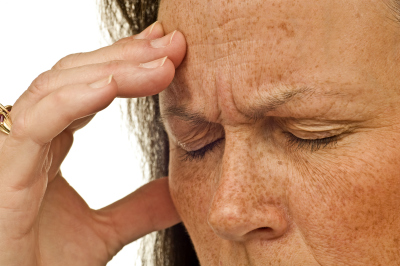
Tension headaches, the most common type of headache, are characterized by mild to moderate pain that is usually focused across the forehead.
A Sympathetic Block is an injection that numbs branches of nerves which can reduce Tension Headache.
• Tension headaches may be Chronic, occurring Frequently or Every Day
• Stress and Muscle Tension are often factors
• Typically don’t cause nausea, vomiting, or sensitivity to light
• Typically cause a Steady Ache, rather than a Throbbing Ache
• Typically Affecting Both Sides of the Head

What is Chronic Migraine?
The pain of a migraine headache is often described as an intense pulsing or throbbing pain in one area of the head. However, it is much more; the International Headache Society diagnoses a migraine by its pain and number of attacks (at least 5, lasting 4-72 hours if untreated), and additional symptoms including nausea and/or vomiting, or sensitivity to both light and sound. Migraine is three times more common in women than in men and affects more than 10 percent of people worldwide. Roughly one-third of affected individuals can predict the onset of a migraine because it is preceded by an “aura,” visual disturbances that appear as flashing lights, zig-zag lines or a temporary loss of vision. People with migraine tend to have recurring attacks triggered by a number of different factors, including stress, anxiety, hormonal changes, bright or flashing lights, lack of food or sleep, and dietary substances. Migraine in some women may relate to changes in hormones and hormonal levels during their menstrual cycle. For many years, scientists believed that migraines were linked to the dilation and constriction of blood vessels in the head. Investigators now believe that migraine has a genetic cause.
Is there any treatment?
There is no absolute cure for migraine since its pathophysiology has yet to be fully understood. There are two ways to approach the treatment of migraine headache with drugs: prevent the attacks, or relieve the symptoms during the attacks. Prevention involves the use of medications and behavioral changes. Drugs originally developed for epilepsy, depression, or high blood pressure to prevent future attacks have been shown to be extremely effective in treating migraine. Botulinum toxin A has been shown to be effective in prevention of chronic migraine. Behaviorally, stress management strategies, such as exercise, relaxation techniques, biofeedback mechanisms, and other therapies designed to limit daily discomfort, may reduce the number and severity of migraine attacks. Making a log of personal triggers of migraine can also provide useful information for trigger-avoiding lifestyle changes, including dietary considerations, eating regularly scheduled meals with adequate hydration, stopping certain medications, and establishing a consistent sleep schedule. Hormone therapy may help some women whose migraines seem to be linked to their menstrual cycle. A weight loss program is recommended for obese individuals with migraine.
Relief of symptoms, or acute treatments, during attacks consists of sumatriptan, ergotamine drugs, and analgesics such as ibuprofen and aspirin. The sooner these treatments are administered, the more effective they are.
What is the prognosis?
Responsive prevention and treatment of migraine is incredibly important. Evidence shows an increased sensitivity after each successive attack, eventually leading to chronic daily migraine in some individuals With proper combination of drugs for prevention and treatment of migraine attacks most individuals can overcome much of the discomfort from this debilitating disorder. Women whose migraine attacks occur in association with their menstrual cycle are likely to have fewer attacks and milder symptoms after menopause.
Prepared by:
Office of Communications and Public Liaison
National Institute of Neurological Disorders and Stroke
National Institutes of Health
Bethesda, MD 20892
- NINDS health-related material is provided for information purposes only and does not necessarily represent endorsement by or an official position of the National Institute of Neurological Disorders and Stroke or any other Federal agency. Advice on the treatment or care of an individual patient should be obtained through consultation with a physician who has examined that patient or is familiar with that patient’s medical history.
- All NINDS-prepared information is in the public domain and may be freely copied. Credit to the NINDS or the NIH is appreciated.
- Last Modified November 3, 2015
A migraine is an intense, throbbing headache that may be accompanied by nausea or dizziness. A migraine can last from hours to days.
• Migraine is an extremely incapacitating collection of neurological symptoms
• Migraine is most common between the ages of 25 and 55
• Attacks usually last between 4 and 72 hours
• 3rd most Prevalent Illness in the world, 12% of the Population
• 18% of American women, 6% of men, and 10% of children experience migraines
• More than 4 million people experience Chronic Daily Migraine (least 15 migraine days monthy)
• 90% of sufferers are unable to work or function normally during their migraine
• It’s typically a severe throbbing recurring pain, usually on one side of the head; in about 1/3 of attacks, both sides are affected
• Attacks are often accompanied by one or more of the following: visual disturbances, nausea, vomiting, dizziness, extreme sensitivity to sound, light, touch and smell, and tingling or numbness in the extremities or face.
• In 15-20% of attacks, other neurological symptoms occur before the actual head pain
![]()
BOTOX® is the first and only FDA-approved treatment for Chronic Migraine that prevents headaches and migraines before they even start

BOTOX® is a preventive treatment that’s injected by a specialist every 12 weeks
BOTOX® prevents on average 8 to 9 headache days and migraine/probable migraine days a month (vs 6 to 7 for placebo)

100,000 people with Chronic Migraine have been treated with BOTOX® since FDA approval in 2010

